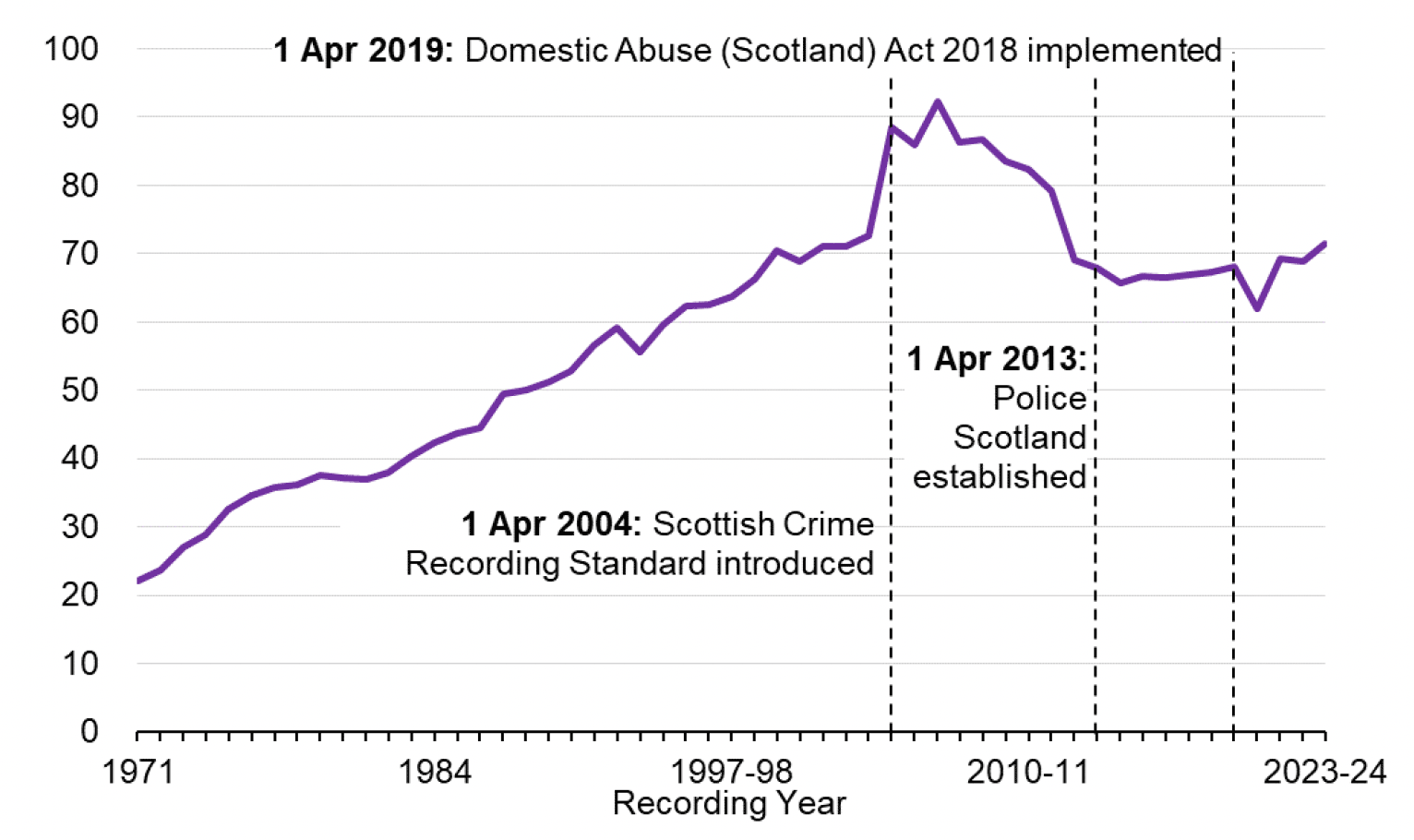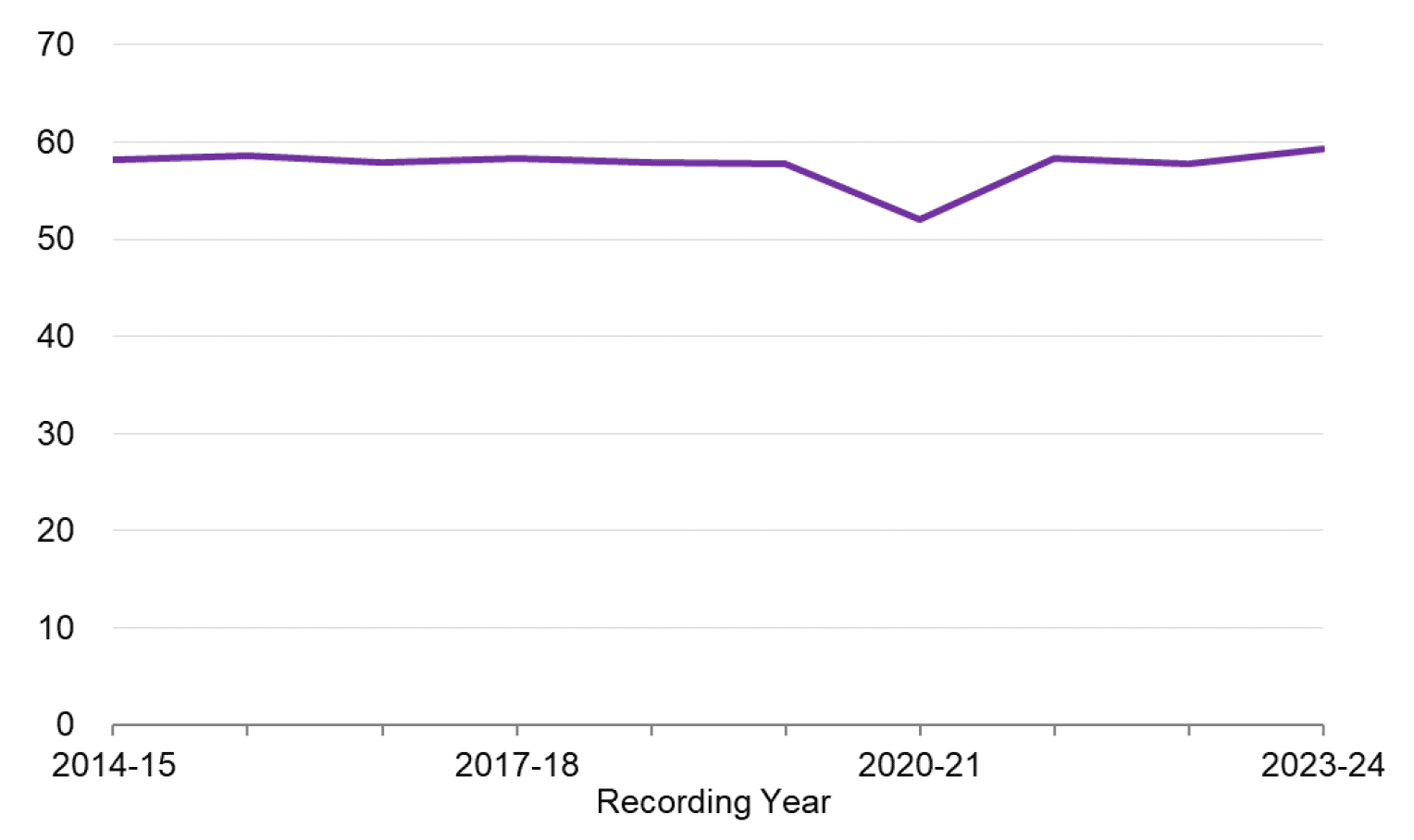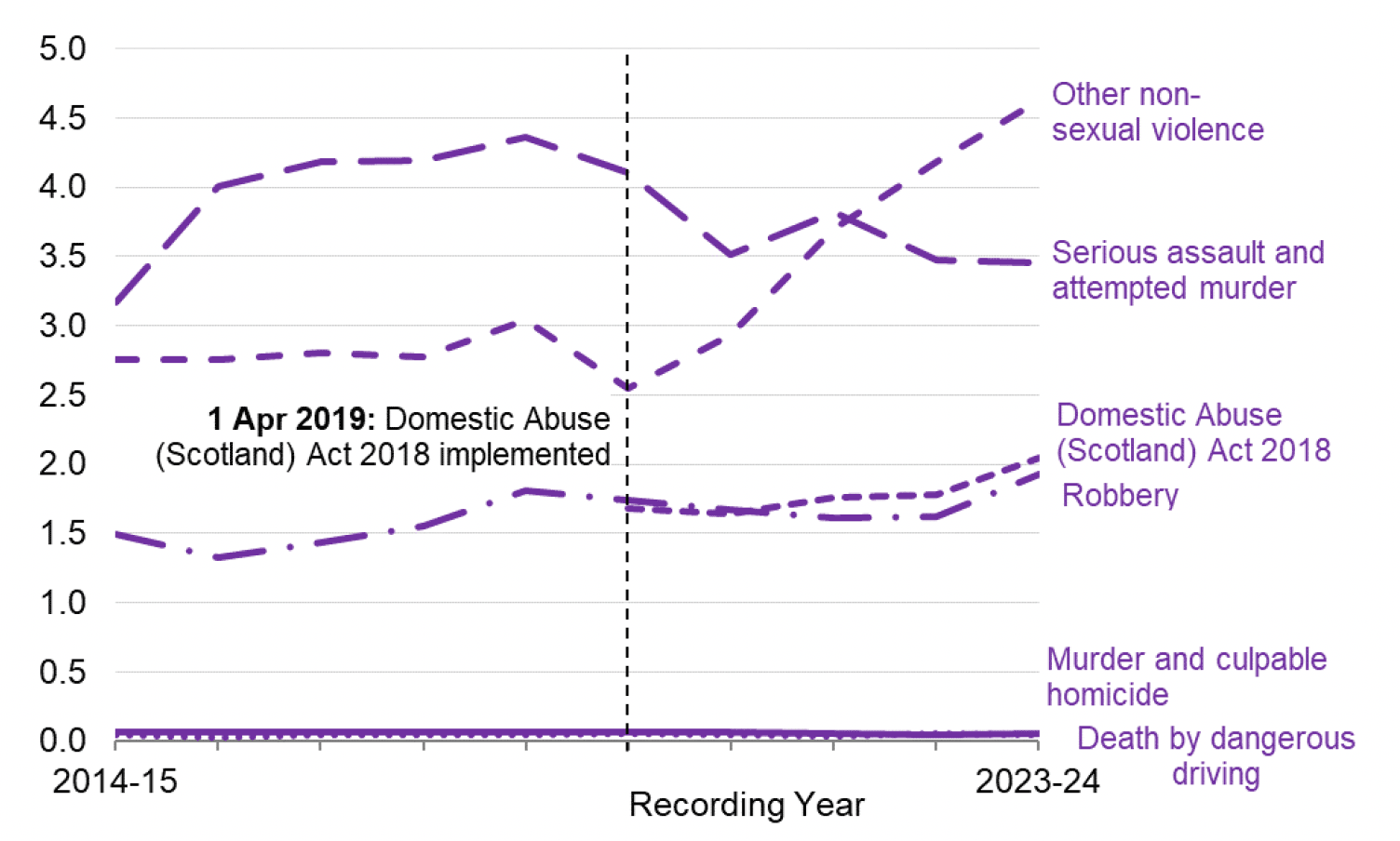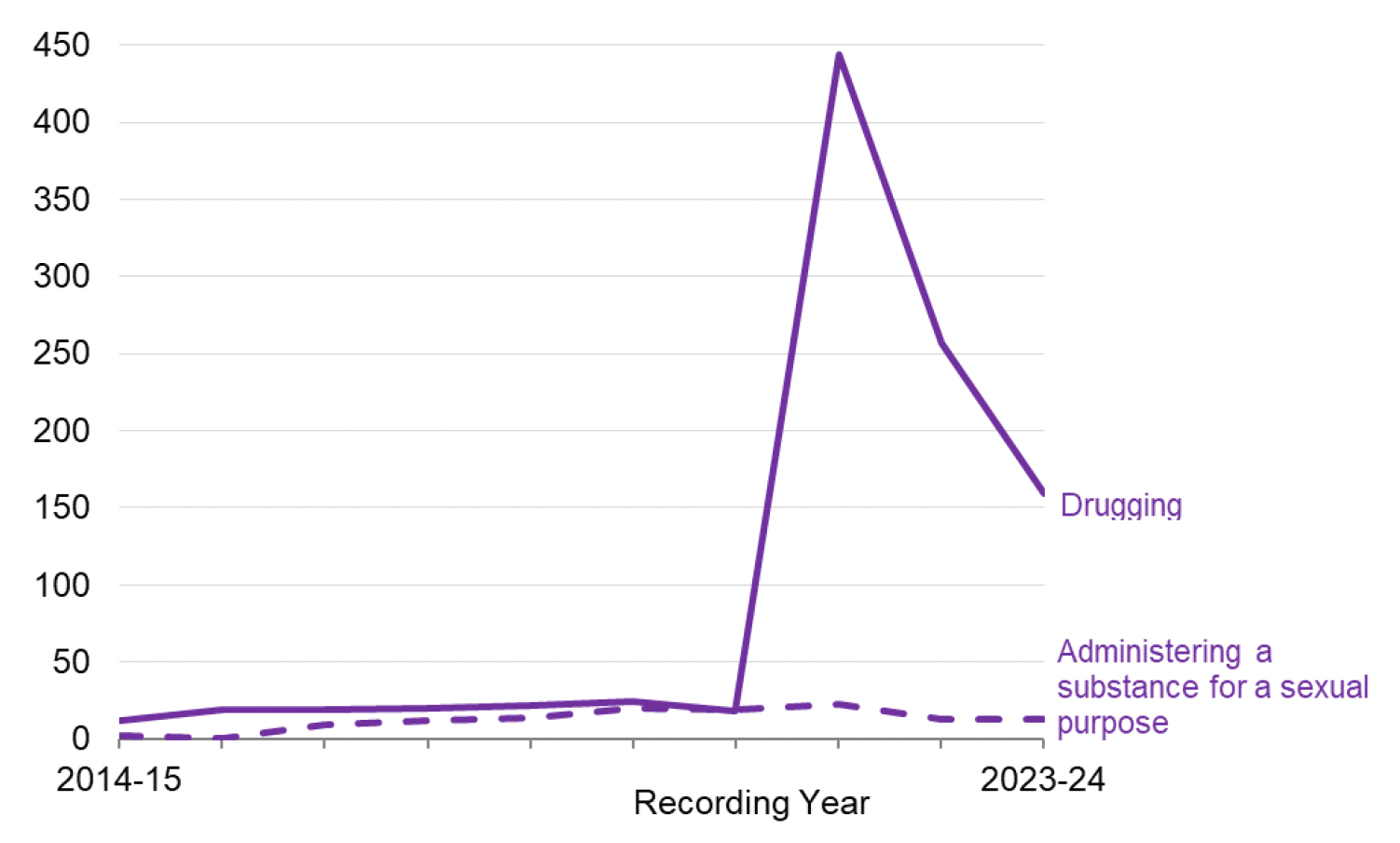Recorded Crime in Scotland, 2023-24
Statistics on crimes and offences recorded and cleared up by the police in Scotland in 2023-24, split by crime or offence group and by local authority.
Non-sexual Crimes of Violence

Non-sexual crimes of violence accounted for almost a quarter (or 24%) of all crimes recorded in Scotland in 2023-24. Between 2022-23 and 2023-24, the number of Non-sexual crimes of violence recorded by the police in Scotland increased by 4%, from 68,870 to 71,463.
The clear majority (83% in 2023-24) of Non-sexual crimes of violence are crimes of Common assault. Due to the size of this crime category within the group, any changes to the trend in Common assault will significantly impact the trend for the group as a whole. As such, the 4% increase in Non-sexual crimes of violence in this latest year, is primarily due to a 3% increase in Common assault. The next biggest contributors by volume were other non-sexual violence (up 11%) and Robbery (up 18%).
This is the fifth year of crimes being recorded within the Non-sexual crimes of violence group, under the Domestic Abuse (Scotland) Act 2018 – following its enactment on the 1 April 2019. There were 2,042 such crimes recorded in 2023-24, accounting for 3% of Non-sexual crimes of violence.
Chart 4 below shows the number of Non-sexual crimes of violence from 1971 onwards. Levels of violent crime increased for a long period, before entering a downward trend following a peak in 2006-07. There has been a 22% reduction in Non-sexual crimes of violence since 2006-07. Looking at the latest ten years as a whole, the number of Non-sexual crimes of violence has increased by 9% from 65,701 in 2014-15 to 71,463 in 2023-24.
Non-sexual crimes of violence are at a significantly higher level than in 1971 and have remained above 60,000 since 1995-96.

Note: Data are incomplete for 1975 due to local government reorganisation.
The national rate of recorded Non-sexual crimes of violence has increased from 126 crimes per 10,000 population to 131 crimes per 10,000 population between 2022-23 and 2023-24.
In 2023-24, of all Non-sexual crimes of violence:
- Common assault made up the vast majority, accounting for 83%
- Other non-sexual violence accounted for 6%
- Serious assault and attempted murder accounted for 5%
- Crimes under the Domestic Abuse (Scotland) Act 2018 accounted for 3%
- Robbery accounted for 3%
- Murder and culpable homicide and Death by dangerous driving both contributed very small proportions (both less than 0.1%) of the total
Chart 5 shows the number of Common assault crimes recorded over the latest ten years. This is presented separately from all other categories within Non-sexual crimes of violence due to the larger scale of crimes recorded in this category.
Common assault has remained between 50,000 and 60,000 recorded crimes over the last ten years.

Chart 6 presents all other crime categories within Non-sexual crimes of violence over the latest ten years and gives an indication of the trend and scale of each category.
Other non-sexual violence and Serious assault and attempted murder have been the largest categories of Non-sexual crimes of violence after Common assault in each of the last ten years.

The following sections discuss in more detail the trends for each crime category within the Non-sexual crimes of violence crime group. These are:
- Murder and culpable homicide
- Death by dangerous driving
- Serious assault and attempted murder
- Common assault
- Robbery
- Domestic Abuse (Scotland) Act 2018
- Other non-sexual violence
Further details for some categories can be found in the 'Supporting documents' Excel workbook.
Murder and culpable homicide
Murder and culpable homicide accounted for a very small proportion (less than 1%) of Non-sexual crimes of violence. Crimes recorded in this category decreased by 8% over the ten year period from 2014-15 to 2023-24. However, there was a 21% increase between 2022-23 and 2023-24, from 48 to 58 recorded crimes.
Data comparisons: Homicide in Scotland Accredited Official Statistics
The Scottish Government produce a separate Homicide in Scotland statistics bulletin. It contains detailed information on the crimes of Murder and Culpable homicide (common law). It presents characteristics of victims and accused, such as age and gender and the circumstances of the homicide. Users interested in Homicide statistics should use the Homicide in Scotland statistics bulletin.
The latest bulletin reports on the year of 2022-23. The data showed a decrease in the number of homicide victims compared to 2021-22, from 53 to 52. This was the lowest number since comparable records began in 1976.
Death by dangerous driving
Causing Death by dangerous driving accounted for a very small proportion (less than 1%) of Non-sexual crimes of violence. Crimes recorded in this category remained unchanged over the ten year period from 2014-15 to 2023-24. However, there has been a 16% decrease in the most recent year, from 50 crimes recorded in 2022-23 to 42 in 2023-24.
Serious assault and attempted murder
Serious assault and attempted murder accounted for 5% of Non-sexual crimes of violence. Crimes recorded in this category decreased by 1% between 2022-23 and 2023-24, from 3,476 to 3,457. Over the ten-year period from 2014-15 to 2023-24, this category has seen an increase of 9%, from 3,166 to 3,457.
These crimes increased year-on-year between 2014-15 and 2018-19, before decreasing each year since then, apart from 2021-22. At least part of the sharp increase seen in 2015-16 was attributed by Police Scotland to the introduction of enhanced guidance for recording Serious assault in January 2015. The latest figure remains 21% lower than the peak in 2018-19.
For the definition of Serious assault and the distinction between Serious assault and Common assault please see Annex 1.
We previously published the findings of a more detailed study into Attempted murder & serious assault on our website.
One subset of the Serious assault and attempted murder category is the crime of Serious assault of retail worker, which came into effect on the 24 August 2021. This was introduced by the Protection of Workers (Retail and Age-restricted Goods and Services) (Scotland) Act 2021. As such, the first statistics for 2021-22 only related to a partial year. There were 13 such crimes recorded in 2023-24 (compared to 15 the year before). More information on this new legislation is provided in Annex 3.
Data comparisons: Public Health Scotland Emergency Hospital Admissions as a result of Assault
Another source of statistics on assault is Public Health Scotland’s annual publication on hospital admissions due to unintentional injuries. This includes the number of emergency hospital admissions for assault.
The latest published figures are for 2022-23 and are available at: Unintentional injuries - Hospital admissions year ending 31 March 2023 and deaths year ending 31 December 2022 - Unintentional injuries - Publications - Public Health Scotland
There are several reasons why direct comparisons cannot be made between the two sources. For example, not all who attend hospital with assault injuries will report what has happened to the police, and many recorded assaults will not require inpatient hospital treatment. However, as these sources both generally relate to how Scotland’s emergency services respond to the most serious types of assault, it would be anticipated that both should show similar trends over time.
In 2015, enhanced guidance was introduced which helped clarify the differences between the recording of serious assault and common assault. This very likely played a significant role in the 27% increase in police recorded serious assault and attempted murder in 2015-16 (and perhaps to a lesser extent the 4% increase in 2016-17). Looking at the years which followed, the police and hospital-based measures moved in a similar direction, with a 19% fall in emergency hospital admissions due to assault between 2016-17 and 2020-21, and a 16% decrease in police recorded serious assault and attempted murder over the same period.
In 2022-23 (the latest year for which statistics are available from both sources), there was a similar coherence with a decrease in recorded serious assault and attempted murder, and a continued fall in hospital admissions for assault. Recorded serious assault and attempted murder then fell again in 2023-24. The first post-pandemic findings of the Scottish Crime and Justice Survey (published in November 2023) also provide an additional measure on violent crime victimisation (including those cases not reported to the police), to help inform users about the latest trends in non-sexual violence in Scotland.
Common assault
Common assault is the largest category of Non-sexual crimes of violence, accounting for 83% in 2023-24. Over the ten-year period from 2014-15 to 2023-24, the number of crimes recorded in this category has risen by 2%. There was a 3% increase between 2022-23 and 2023-24 (from 57,708 to 59,314). This is a higher level to the position prior to the COVID-19 pandemic (in 2019-20).
Of the 59,314 crimes recorded in 2023-24, 7,972 (13%) related to Common assault of emergency workers, an increase of 5% since 2022-23 and an increase of 23% since 2014-15. Another subset of the Common assault category is the crime of Common assault of retail worker, with 2,555 such crimes (4% of all Common assault) recorded in 2023-24. The crime of Common assault of retail worker came into effect on the 24 August 2021, introduced by the Protection of Workers (Retail and Age-restricted Goods and Services) (Scotland) Act 2021. As such, the first statistics for 2021-22 only related to a partial year. More information on this new legislation is provided in Annex 3.
Robbery
Robbery accounted for 3% of Non-sexual crimes of violence. Over the ten year period from 2014-15 to 2023-24, this category has seen an increase of 28%. Following increases between 2015-16 and 2018-19, there were decreases for the three years between 2019-20 and 2021-22, before increasing again in each of the last two years. There was an 18% increase between 2022-23 and 2023-24 (from 1,623 to 1,922).
We previously published the findings of a more detailed study into Robbery. Further information is available on our website.
Domestic Abuse (Scotland) Act 2018
Crimes recorded under the Domestic Abuse (Scotland) Act 2018 accounted for 3% of Non-sexual crimes of violence. There were 2,042 crimes recorded under the Domestic Abuse (Scotland) Act 2018 in 2023-24, the fifth year this legislation has been in place. This was a 15% increase compared to 2022-23 (from 1,781 to 2,042).
Of those crimes, 94% (or 1,921) involved a female victim and 6% (or 121) had a male victim.
It should be noted that crimes under the Domestic Abuse (Scotland) Act 2018 relate to a course of conduct only and therefore do not include all crimes relating to domestic abuse.
Annex 2 provides information on the results of HMICS Crime Audit 2020, which also examined a sample of incidents relating to domestic abuse.
Data comparisons: Official Statistics on Domestic Abuse recorded by the police in Scotland
Statistics presented in this bulletin are the primary source for users interested in the number of crimes recorded under the Domestic Abuse (Scotland) Act 2018.
However, separate analysis of domestic abuse incidents reported to the police is presented in the Domestic abuse: statistics recorded by the police in Scotland Official Statistics bulletin. This is produced by the Scottish Government and contains details of domestic abuse incidents and crimes recorded by Police Scotland, including characteristics of victims and perpetrators, such as their age and gender.
The next Domestic abuse recorded by the police in Scotland bulletin will contain data for 2023-24 and will be published this financial year.
Other non-sexual violence
The Other non-sexual violence category includes a wide range of crime types, albeit just four accounted for 91% of the 4,628 crimes recorded in 2023-24. This included Threats & extortion (52% of all Other non-sexual violent crimes), Stalking (19%), Cruelty to & unnatural treatment of children (13%) and Abduction (6%). More detail on the crimes included is provided in the User Guide.
Crimes recorded as Other non-sexual violence accounted for 6% of Non-sexual crimes of violence in 2023-24. Over the ten year period from 2014-15 to 2023-24 this category has seen an increase of 68%, including an increase of 11% from 4,184 in 2022-23 to 4,628 in 2023-24.
These increases are primarily due to increases in crimes of Threats and extortion, which are up 20% in the latest year (from 2,008 in 2022-23 to 2,417 in 2023-24) and are more than ten times higher than ten years ago (from 240 in 2014-15). Eighty-six percent of crimes of Threats and extortion were estimated to be cyber-crimes in 2023-24 (further information on this is available in the Cyber-crime chapter).
The number of drugging crimes has fallen by 38% from 257 in 2022-23 to 159 in 2023-24, however they remain substantially higher than the period from 2014-15 to 2020-21 when no more than 24 drugging crimes were recorded in any year.
How Spiking is covered within the recorded crime statistics
Spiking, whether by adding drugs or alcohol to someone’s drink, by injection, or by any other means, without their consent, is a criminal offence and can put people at risk of significant harm.
As with all crimes in Scotland, crimes of spiking are recorded in accordance with the Scottish Crime Recording Standard. There is no specific crime classification for ‘spiking’, however depending on the circumstances the potentially relevant crime classifications are as follows:
Drugging - a Common Law crime when drugs are feloniously administered with intent to produce stupefaction. There need be no further intent, and it is not necessary that any injury to the person be caused.
Administering a substance for sexual purposes - Section 11 of the Sexual Offences Scotland Act 2009. Administering a substance for the purpose of stupefying or overpowering, so as to enable a sexual activity
Assault – In circumstances where there is no evidence of drugging found, however evidence of an injury is present, the recording of an Assault may be appropriate. However unlike crimes of Drugging and Administering a substance for sexual purposes, it isn’t possible to identify any such specific cases within the Police Recorded Crime Accredited Official Statistics.
Police Recorded Crime Accredited Official Statistics
The recorded crime statistics show that between 2014-15 and 2020-21 there were on average 19 crimes of drugging and 11 crimes of administering a substance for sexual purposes per year. In 2021-22 crimes of Drugging then rapidly increased to a peak of 444. This was likely due, at least in part, to the significant coverage on national and social media of the issue of spiking during the autumn of 2021. Crimes of Drugging then reduced to 257 in 2022-23, and 159 in 2023-24. Crimes of administering a substance for sexual purposes didn’t see the same increase and have remained relatively stable, peaking at 23 in 2021-22, before decreasing to 13 in both 2022-23 and 2023-24.
Drugging has been at a much higher recorded level in the latest three years than prior to its peak in 2021-22.

Police Scotland Management Information
Police recorded crime accredited official statistics are produced using aggregate counts at crime code level. Given this, the Scottish Government does not hold the information necessary to undertake further analysis on the characteristics of these crimes. However some additional analysis has been carried out by Police Scotland and is provided below. The following information was obtained from data collected by Police Scotland and should be considered management information, not official statistics. The information was correct as of April 2024, but due to the manner in which the data is gathered, it is subject to fluctuation and change depending on updates and outcomes from investigations.
Of the crimes identified by Police Scotland as being potentially spiking-related during 2023-24;
- Around two-thirds of crimes reported are suspected to have involved a drink being spiked. Very few (3%) are suspected to have involved spiking by needle. In just under a third of cases the method is unknown.
- Three-quarters of crimes took place in licensed premises, while 15% occurred in residential settings.
- In 12% of crimes there was a secondary offence recorded, with half (50%) of those offences involving a sexual motive.
- October and December were the months where most crimes were recorded (this does not follow the same pattern as 2022-2023).
- Most crimes (86%) were reported by females.
- Around two-fifths (41%) of people reporting crimes were aged between 16 and 20 years, and around three-quarters (75%) were aged between 16 and 30 years. This compares to 6% of Scotland’s population aged 16-20 and 18% aged 16 to 30.
- One third (32%) of people reporting crimes were students.
- Of the perpetrators identified, the vast majority (93%) were male.
Contact
Email: Justice_Analysts@gov.scot
There is a problem
Thanks for your feedback